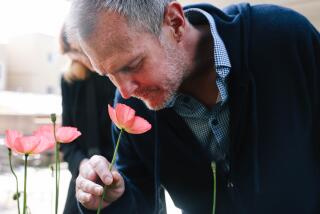2-Year-Old Beats the Odds Against 9-Syllable Disorder
The brown-haired boy frolics like most 2-year-olds, squealing, jumping on his rocking horse, causing the usual havoc and making it nearly impossible at times for his parents to carry on a conversation.
Not long ago such childhood pleasures would have been all but impossible for Sawyer Leestma. The Huntington Beach boy was born with the rare genetic condition mucopolysaccharidosis. It can ravage the entire body, leading to mental retardation, blindness, joint problems and kidney, liver and heart disease.
Also known as MPS 1, or Hurler syndrome, the disease affects one in 100,000 people. “It’s one of those things they teach in medical school and test on the boards and you never see again,” said Dr. Elizabeth O’Connell, Sawyer’s pediatrician.
It occurs when the body lacks the enzyme to break down sugar molecules.
Sawyer’s treatment took place over two months at Children’s Hospital of Orange County. Conventional treatment calls for a bone marrow transplant, which enables the body to produce the missing enzyme.
To give Sawyer a head start while he waited for a donor, doctors began treating him with weekly intravenous enzyme therapy, making him, his doctors say, the first patient to be treated with that combination.
The intravenous treatment alone is insufficient because it does not enter the brain and prevent mental retardation. It is also expensive: $80,000 to $100,000 a year.
Dr. Charles Peters, a Hurler syndrome expert at the University of Minnesota School of Medicine, said enzyme therapy makes the transplant safer by strengthening the patient and reducing lung complications.
“But only time will tell us in terms of greater numbers of patients being treated this way,” he said.
Before the bone marrow transplant, Sawyer was lethargic and developmentally slow. He suffered hernias, a spine deformity, an enlarged liver and frequent upper respiratory and ear infections. Hair grew on his forehead and on his back.
Dr. Jose Abdenur, medical director of metabolic disorders at CHOC, who was in charge of Sawyer’s treatment, said the boy is recovering.
“He cannot perhaps run and jump exactly like other children his age, but otherwise -- intellectually, verbally -- he’s doing perfect,” Abdenur said.
The disease thickened his lips and broadened his nose, but his features are softening, said his parents, Michele and Charles Leestma. They said the disease has also left their son with an enlarged mitral valve in his heart, and his vision is impaired -- they liken it to looking through a dirty window.
Peters said he tells parents that a bone marrow transplant is not a cure, “but your child will have a chance at long-term survival.” Most commonly, those with Hurler syndrome suffer skeletal abnormalities and need orthopedic surgery, he said.
Both parents must carry the gene for a child to develop the disease. There is a 1 in 4 chance the child will be affected.
The Leestmas have a 5-year-old daughter, Brooke, who does not have Hurler’s. But there is a 50% chance she is a carrier, and they plan to have her tested.
The couple, married for six years, don’t plan to have more children.
The Leestmas said they haven’t had time to ponder that they passed a defective gene to their son. “In the hospital, you don’t have time to dwell on it,” said Charles, 38, an engineer.
“We just went into battle mode,” added Michele.
Sawyer was sick almost from the time he was born Nov. 7, 2002. He has suffered from an enlarged cornea, a hernia and had trouble breathing. He was in the doctor’s office almost every week.
Sawyer’s pediatrician sent him for genetic testing in May 2003. The Leestmas learned of their son’s disease the next month, two days before Father’s Day.
“It was almost like a brick falling from the sky,” said Michele, 34, an ultrasound technologist. “It was absolutely sickening.”
They were told their son had a medium-level case, which meant he could live into his teens without treatment. In the worst cases, the child dies by 10.
A bone marrow transplant has a 5% to 10% mortality rate, Abdenur said.
During the nearly three months doctors sought a donor, Sawyer spent eight hours each week receiving the enzyme therapy. Once the transplant match was made, chemotherapy was begun to knock out his immune system so he could accept the new marrow. As with cancer patients, his hair and eyebrows fell out.
The day before the transplant, the then-anonymous donor sent him a stuffed brown bear that his 3-year-old daughter picked out. To this day, Sawyer sleeps with it.
Sawyer stayed at CHOC for two months, with his parents and Michele’s parents taking shifts at his bedside around the clock. The hospital was where he learned to crawl.
He was released from CHOC on Dec. 17, but because the drugs he was taking to prevent him from rejecting the marrow weakened his immune system, Sawyer kept getting sick and spent time back in the hospital.
It will be another year before Sawyer’s immune system is back to normal, Charles said. The family keeps the house extra clean, with air filters installed to keep out bacteria. The family’s lab/Rottweiler mix stays outdoors, and Sawyer isn’t allowed to play with him, for fear that the dog pass on germs.
But their son, dressed in his red pants and gray sweatshirt, can run about, shooting baskets at his miniature hoop.
“He just does a lot of things a normal 2-year-old does,” Charles Leestma said.







